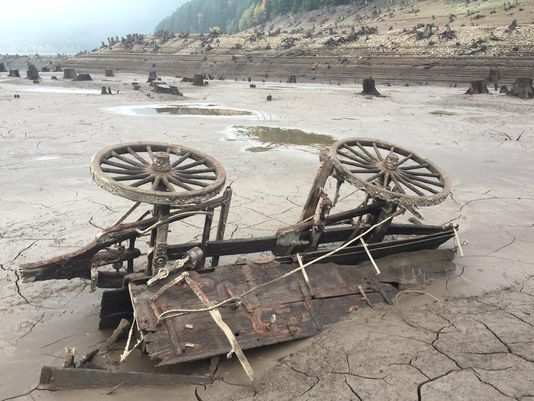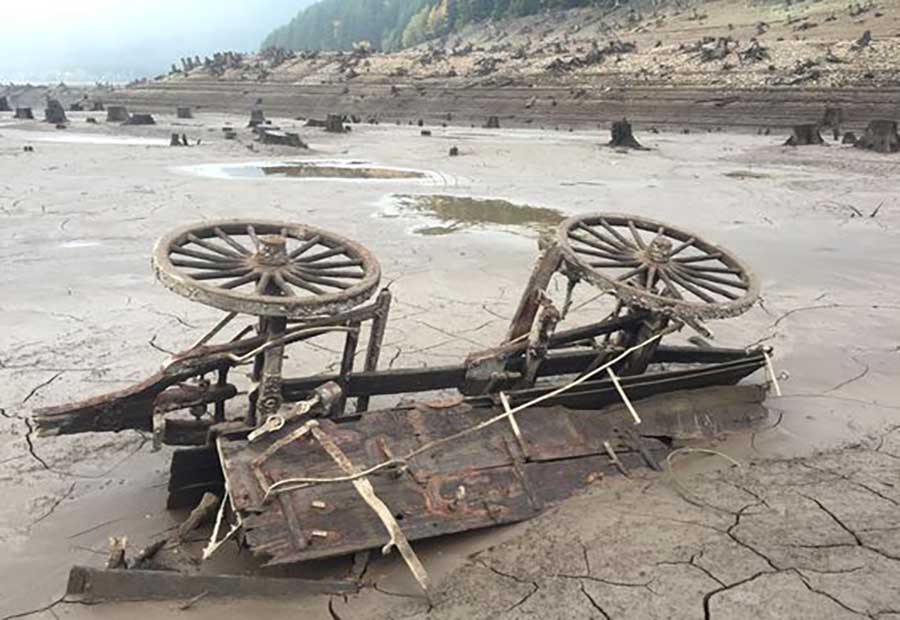19th-Century Wagon Discovered at Detroit Lake Amid Record-Low Water Levels
The unprecedented drought on the West Coast of the United States that has lasted for over four years now has had a major impact on everything from water supplies to agriculture to fisheries.
But in one town in Oregon, the resulting historic low water levels have dredged up history: the remains of a town that was abandoned and sunk beneath a reservoir more than 60 years ago.
Back in 1953, the 200 residents of the tiny town of Old Detroit deserted their homes after Congress approved a nearby dam, which, when finished, would flood the area to create the reservoir now known as the Detroit Lake.
Ever since the lake’s water level fell, remnants of the town would sometimes rise out of the water. With the lake’s water level at a record low this year, when a local sheriff’s deputy drove past the lake in late October to take a look, he discovered the perfectly preserved remains of a 19th-century wagon, half-sunk in the mud.

“I went on a treasure hunt down along the river, figuring I’d find foundations or something like that,” Marion County Sheriff’s Deputy Dave Zahn tells Christena Brooks for the Statesman Journal. “Then I saw a piece of old history right there.”
The lack of snowfall last winter caused Detroit Lake’s water levels to drop to the lowest they’ve been in almost 50 years, approximately 143 feet below capacity.
When Zahn decided to poke around in the newly dry lake bed, he discovered the utility wagon alongside an octagonal pit lined with cement that experts still haven’t identified, Brooks reports.
“As far as I know, the wagon’s never been seen until this year,” U.S. Forest Service archaeologist Cara Kelly tells Brooks. “This might not have been its original resting place…It could’ve come from anywhere in the town of Detroit or even up the drainage.”
While Zahn first spotted the wagon on October 29, he and Kelly decided to keep its location a secret, so as not to attract potential looters and vandals.
According to a metal plate attached to the wagon as seen in some of Zahn’s photographs, the wagon was made in 1875 by the Milburn Wagon Company of Toledo, Ohio, which was one of the country’s largest manufacturers of wagons at the time.
As Brooks reports, the lake bottom’s low oxygen levels almost perfectly preserved the wagon – ironically, its brief stint on land probably damaged it more than all the decades it spent underwater.
Old Detroit isn’t the only town briefly revealed by a historic drought: that same month, a drought in the Mexican state of Chiapas uncovered the ruins of a 450-year-old church.
The “Temple of Quechula,” as it is known, was originally built by Dominican monks near a conquistador highway but was abandoned in the 18th century after a series of plagues struck the region.
This year, lake levels dropped so low that locals were able to take tourists out to see the ruins.
Even though Oregon’s drought may have uncovered a reminder of Detroit’s history, this year’s dry weather had such a bad effect on the town that Zahn hopes his once-in-a-lifetime experience stays that way.
“Hopefully it will be another 40 years before Detroit’s this low again,” Zahn tells Brooks.




